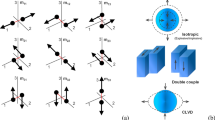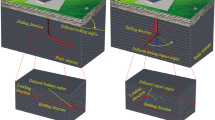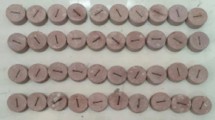Abstract
The time-dependent characteristics of reservoir performance, where deep shale (vertical depth > 3500 m) interacts with fracturing fluid at high temperature and pressure (HTHP) during or after hydraulic fracturing, are closely related to the optimal design of fracturing in adjacent sections. However, the available information on the effect of hydration under HTHP on shale properties is insufficient, especially since the interaction between fracturing fluid and shales with different mineral compositions has rarely been considered comprehensively. In this study, fluid–shale interactions under HTHP were investigated for typical marine shales with different mineral contents (clay-rich, quartz-rich, and carbonate-rich) collected from the Wufeng–Longmaxi Formation in the southern Sichuan Basin, China. The time-dependent characteristics of the mechanical, brittleness, and fracture behaviors of immersion-treated samples at different soaking times were characterized by triaxial compression tests, and X-ray microcomputed tomography (CT) scans of post-test samples. The results show that the evolution of the mechanical parameters with soaking time is different for the three types of shales. The effect of hydration under HTHP on the strength of clay-rich shale and carbonate-rich shale except for the 15-day soaking case ranges from 39.24% to 54.88% and 24.05% to 33.99%, respectively, while the effect on quartz-rich shale is relatively slight, within 20%. The effect of hydration on the shale brittleness was evaluated based on a three-part energy-based brittleness index, in descending order, clay-rich shale > carbonate-rich shale > quartz-rich shale. The crack initiation and propagation during the deformation and failure of the soaked sample are more likely to extend along the direction of the hydration crack. For cases exhibiting quasi-ductile characteristics, hydration-induced microcracks may extend over almost the entire sample, allowing locally concentrated stresses in the immersed sample to be dispersed into each crack during deformation. The experimental results can provide data support and theoretical guidance for fracturing design in deep shale gas exploration in southern Sichuan.
Highlights
-
The evolution of the mechanical and brittleness parameters of THMC-treated shale with soaking time was characterized quantitatively.
-
A three-part energy-based brittleness index, where each part has a well-defined physical meaning related to brittle failure, was used to characterize the shale brittleness at different soaking times.
-
The effect of soaking time and mineral composition on the hydration-induced deterioration of shale was investigated.
-
The deterioration mechanism of THMC-treated shales with different mineral compositions (clay-rich, carbonate-rich, and quartz-rich) was revealed.

















Similar content being viewed by others
Data availability
The authors are unable or have chosen not to specify which data has been used.
References
An Q et al (2022) Influence of mineralogy on rock mechanical behaviour considering dynamic alteration damage caused by sc-co2: a comparative study on different rock types. Rock Mech Rock Eng 6:55
Bai J, Kang Y, Chen Z, You L, Li X (2020) Changes in retained fracturing fluid properties and their effect on shale mechanical properties. J Nat Gas Sci Eng 75:103163
Cao H, Zhao Y, Gao Q, Bao T, Sun P (2021) An insight into shale’s time-dependent brittleness based on the dynamic mechanical characteristics induced by fracturing fluid invasion. J Nat Gas Sci Eng 96:104312
Cao H, Chen Y, Gao Q (2022) Experimental investigation on the shale’s time-dependent microphysical characteristics under the fluid–shale interaction. J Petrol Sci Eng. https://doi.org/10.1016/j.petrol.2022.110418
Fakcharoenphol P, Torcuk M, Kazemi H, Wu Y-S (2016) Effect of shut-in time on gas flow rate in hydraulic fractured shale reservoirs. J Nat Gas Sci Eng 32:109–121
Fatah A, Ben Mahmud H, Bennour Z, Gholami R, Hossain M (2022) The impact of supercritical CO2 on the pore structure and storage capacity of shales. J Nat Gas Sci Eng 98:104394
Feng G, Kang Y, Wang X, Hu Y, Li X (2020) Investigation on the failure characteristics and fracture classification of shale under brazilian test conditions. Rock Mech Rock Eng 53(7):3325–3340
Feng, G., Kang, Y., Sun, Z.D., Wang, X.C. and Hu, Y.Q., 2019. Effects of supercritical CO_2 adsorption on the mechanical characteristics and failure mechanisms of shale. Energy, (Apr.15): 173.
Hou Z, Gutierrez M, Wang A, Almrabat A (2018) Mechanical properties and brittleness of shale with different degrees of fracturing-fluid saturation. Curr Sci 115(6):1163–1173
Hu Y et al (2020) Mechanisms of fracturing fluid spontaneous imbibition behavior in shale reservoir: A review. J Nat Gas Sci Eng 82:103498
Hu J, Xie H, Gao M, Li C, Sun Q (2022) Damage mechanism and heat transfer characteristics of limestone after thermal shock cycle treatments based on geothermal development. Int J Rock Mech Min Sci 160:105269
Hua G et al (2021) Rock physical and chemical alterations during the in-situ interaction between fracturing fluid and Silurian organic-rich shales in China. J Nat Gas Sci Eng 94:104075
Huang T, Cao L, Cai J, Xu P (2019) Experimental investigation on rock structure and chemical properties of hard brittle shale under different drilling fluids. J Petrol Sci Eng 181:106185
ISRM, Ulusay R, Hudson JA, 2007. The complete ISRM suggested methods for rock characterization, testing and monitoring: 1974–2006. ISRM Commission on Testing Methods. Environ Eng Geosci. 15:47–48
Li Z, Duan Y, Peng Y, Wei M, Wang R (2020) A laboratory study of microcracks variations in shale induced by temperature change. Fuel 280:118636
Liang L, Xiong J, Liu X (2015) Experimental study on crack propagation in shale formations considering hydration and wettability. J Nat Gas Sci Eng 23:492–499
Lyu Q, Tan J, Dick J, Liu Q, Ranjith PG, Li L, Wang Z, Hu C (2019) Stress-strain modeling and brittleness variations of low-clay Shales with CO2/CO2-water imbibition. Rock Mechan Rock Eng 52(7):1
Lyu, Q. et al., 2022. Experimental Study on the Mechanical Properties of Shale After Long-term of Immersion in Fracturing Fluids with Different pH. Rock Mechanics and Rock Engineering.
Meng F et al (2016) Effect of saturated fluid on the failure mode of brittle gas shale. J Nat Gas Sci Eng 35:624–636
Patel R et al (2022) Microstructural and mechanical property characterization of Argillaceous, Kerogen-rich, and Bituminous shale rocks. J Nat Gas Sci Eng 108:104827
Sharma V, Sircar A (2020) Multi-technique characterization of shale reservoir quality parameters. J Nat Gas Sci Eng 75:103125
Song J et al (2021) Shale softening degree and rate induced by fracturing fluid under THMC coupling condition. J Nat Gas Sci Eng 96:104294
Tan J, Hu C, Lyu Q, Feng G, Chen S (2022a) Experimental investigation on the effects of different fracturing fluids on shale surface morphology. J Petrol Sci Eng 212:110356
Tan J, Xie B, Lyu Q, Chen S, Ranjith PG (2022b) Mechanical properties of shale after CO2 and CO2-based fluids imbibition: experimental and modeling study. Rock Mech Rock Eng 55(3):1197–1212
Tarasov B, Potvin Y (2013) Universal criteria for rock brittleness estimation under triaxial compression. Int J Rock Mech Min Sci 59:57–69
Wan, C., Song, Y. and Li, Z., 2022. Variation in the brittle–ductile transition of Longmaxi shale in the Sichuan Basin, China: The significance for shale gas exploration. Journal of Petroleum Science and Engineering (209): 209.
Wang Q, Lyu C, Cole DR (2019) Effects of hydration on fractures and shale permeability under different confining pressures: An experimental study. J Petrol Sci Eng 176:745–753
Wang Y, Liu X, Liang L, Xiong J (2020) Experimental study on the damage of organic-rich shale during water-shale interaction. J Nat Gas Sci Eng 74:103103
Zeng L, Chen Y, Hossain MM, Saeedi A, Xie Q (2019) Wettability alteration induced water uptake in shale oil reservoirs: A geochemical interpretation for oil-brine-OM interaction during hydraulic fracturing. Int J Coal Geol 213:103277
Zhang A, Xie H, Zhang R, Ren L, Zhou J, Gao M, Tan Q (2021a) Dynamic failure behavior of Jinping marble under various preloading conditions corresponding to different depths. Int J Rock Mech Min Sci 148:104959
Zhang W, Zhang D, Zhao J (2021b) Experimental investigation of water sensitivity effects on microscale mechanical behavior of shale. Int J Rock Mech Min Sci 145:104837
Zhang A, Xie H, Zhang R, Gao M, Xie J, Jia Z, Ren L, Zhang Z (2023) Mechanical properties and energy characteristics of coal at different depths under cyclic triaxial loading and unloading. Int J Rock Mech Min Sci 161:105271
Zhao G et al (2022a) Fatigue of granite subjected to cyclic loading at various temperatures: experimental insights from deformation and energy conversion. Geomechanics Geophysics Geo-Energy Geo-Resour 8(2):64
Zhao G, Guo Y, Chang X, Jin P, Hu Y (2022b) Effects of temperature and increasing amplitude cyclic loading on the mechanical properties and energy characteristics of granite. Bulletin Eng Geolo Environment 81(4):1
Zhao J et al (2022c) Ten years of gas shale fracturing in China: review and prospect. Natural Gas Industry B 9(2):158–175
Zhou D et al (2022) Changes in microstructure and mechanical properties of shales exposed to supercritical CO2 and brine. Int J Rock Mech Min Sci 160:105228
Zou C, Zhu R, Chen Z, Ogg JG, Yang Z (2019) Organic-matter-rich shales of China. Earth Sci Rev 189:51–78
Acknowledgements
This work was supported by National Natural Science Foundation of China (No. 52104010, 52104046).
Author information
Authors and Affiliations
Corresponding author
Ethics declarations
Conflict of Interest
The authors declare that they have no competing financial interests or personal relationships that could have appeared to influence the work reported in this paper.
Additional information
Publisher's Note
Springer Nature remains neutral with regard to jurisdictional claims in published maps and institutional affiliations.
Rights and permissions
Springer Nature or its licensor (e.g. a society or other partner) holds exclusive rights to this article under a publishing agreement with the author(s) or other rightsholder(s); author self-archiving of the accepted manuscript version of this article is solely governed by the terms of such publishing agreement and applicable law.
About this article
Cite this article
Zhao, G., Guo, Y., Wang, L. et al. Experimental Study on Mechanical, Brittleness, and Fracture Behavior of Deep Shales Subjected to Fracturing Fluid-Shale Interactions at Reservoir Temperature and In-Situ Stress Conditions. Rock Mech Rock Eng 57, 27–44 (2024). https://doi.org/10.1007/s00603-023-03555-1
Received:
Accepted:
Published:
Issue Date:
DOI: https://doi.org/10.1007/s00603-023-03555-1




